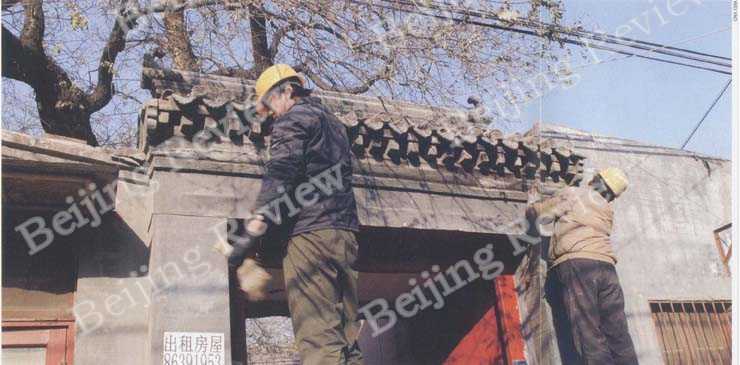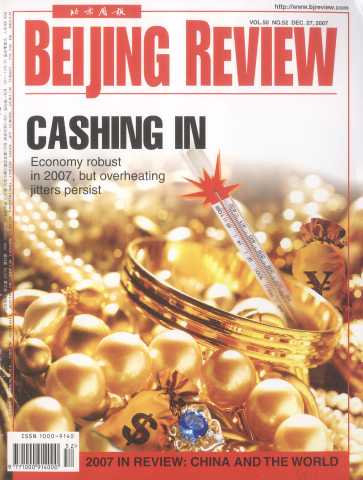After years of watching developers tear down the city's old districts, the Beijing Municipal Government is trying to preserve and enrich what's left
There was a very popular Chinese TV play series a couple of years ago called Zhang Damin's Happy Life. The main character Zhang Damin was a typical Beijing resident who lived in a hutong with his family. All six family members lived in a small shabby room of less than 20 square meters. The cramped situation became even worse after Zhang and his brother got married.
It reflected the living conditions of some older local people who have lived in Beijing for a long time. Most of them live in the old hutongs located in the center of the city. Their houses are small and short of sunshine. They have no private bathrooms or heating system, and are hot in summer and cold in winter.
The situation has to be changed, but how? The former way used to be to pull down the old houses and resettle the residents to other places. This created disputes and destroyed the essence of the old city. In 2001, Feng Jicai, a writer, caught the eye of the public by speaking out against demolishing a street in Tianjin, an old municipality near Beijing. He even shed tears on the subject and called for a united front to protect the street. With his endeavor, the local government decided to cancel the demolition plan and built a museum there instead.
However, building museums is not suitable for all old city areas. Most houses must be for people to live in. Considering the poor living conditions in some older parts of Beijing, how to both preserve the flavor of the old city and ensure the people living there have a good living environment has long been a hot issue. Beijing has been seeking new ways to deal with it. From relying mainly on real estate developers, who simply pulled down all the old houses and built modern apartment buildings, the city has moved toward focusing more on the role of government, which is reconstructing the old city step by step, largely preserving its original look.
A good start
From the beginning of 2004, the Beijing Municipal Construction Commission (BMCC) cancelled 36 expired reconstruction projects in preservation areas and made new plans focusing more on the preservation of old houses. Some experts specializing in preserving cultural relics and urban planning were invited to supervise the new projects. No reconstruction plans can be put into practice without the permission of the experts.

GOOD AS OLD: Workers reconstruct the door of a quadrangle in Xinghua Hutong, Xicheng District
The old city of Beijing mainly refers to the area within the 2nd Ring Road, which occupies 62.5 square km. It not only embodies the essence of the history and culture of Beijing, but also holds very shabby houses and low-income residents. Statistics show that at the end of 2004, in the eight districts of Beijing, ramshackle houses occupied 2.97 million square meters and made up 105,000 households.
In 2005 and 2006, the government of Xicheng District of Beijing took the lead to comprehensively reconstruct the old streets and hutongs, spending 40 million yuan ($5.4 million). Five hutongs, including Qingfeng Hutong, Boxue Hutong and 87 residential compounds were on the list to be modified. The modification includes giving every household a private bathroom, renewing ground bricks, rebuilding the walls for some particularly shabby rooms and painting.
After the reconstruction, the conditions of people living there were greatly improved. The five hutongs took on a fresh look and showed again the atmosphere of old Beijing. Qingfeng Hutong was also selected as one of the top 10 hutongs in Beijing this April.
"I can live in the new house without spending even a penny, and still in my old residential compound where I spent 50 years," said an old man with the surname Qu who lives in Boxue Hutong.
The hutong reconstruction project this year spread to three other districts including Dongcheng, Xuanwu and Chongwen. The local governments have already allocated 250 million yuan ($33.9 million) for the reconstruction of 40 hutongs, which includes 1,474 residential compounds and 9,635 households in four districts. This is the biggest reconstruction of old houses since the founding of the People's Republic of China.
The reconstruction this time is quite different. Instead of tearing down the old houses, replacing them with modern apartment blocks and resettling the residents, the government will restore the old buildings and allow the residents to move back in after the work has been done. That is why the project has been supported by most residents even though they have to find other places to stay for a couple of months during the reconstruction process.
Compared with the former reconstruction projects, which went to extremes, either demolishing everything or doing nothing under the name of preservation, the policy this time is to be economical and practical.
"Former reconstruction focused more on houses and land resources. This time we focus on people," said Huang Yan, Director of Beijing Municipal Commission of Urban Planning.
Living in a new house has been Yang Qinglin's dream for half a century. He used to live in a big residential compound, which held 11 households. Aside from other inconveniences, the shabby flat leaked when it rained. The rocketing housing price of Beijing made it impossible for him to move out.
In October this year, he got a surprise from the government. The residential compound he lives in - No. 16 residential compound in Dongsi Shitiao Hutong - was put on the list for reconstruction. "This is no different from moving to a new house," said Yang, with a big smile.
Plans for the future
There are altogether 13 residential compounds, which are squeezed with ramshackle houses, on the list in this area. Before the reconstruction, the project engineers visited households one by one to collect data and take pictures in order to ensure the area remained the same after reconstruction.
Deputy Director of BMCC Zhang Jiaming recently revealed his commission and the Beijing Municipal Administration of Cultural Heritage will cooperatively organize a group of experts majoring in preserving cultural heritage as consultants for the reconstruction of the four districts. Deputy Chief of Dongcheng District Zhang Zhong described the principle of the reconstruction as "making the old look like old."
"The way to reconstruct the houses varies according to the different styles of them. The difference is even detailed to the types of files covering the roofs, the bricks on the walls and the wood used for doors and windows," said Zhang.
Different areas show a different atmosphere due to the geographic location and social structure. For example, Dongsi Shitiao Hutong was a gathering place for noble people in ancient times, so the yards there after reconstruction will show noble characteristics with high arches and relatively large spaces. The Xilangxia Hutong near to White Pagoda Temple was a place for common people, so the reconstruction project will use blue bricks and doors to depict an atmosphere of common life.
"The governments of the four districts have all taken the specialties of their districts into consideration, so I am sure that they will not look alike," said Zhang of BMCC.
At present, there are 301 residential compounds in Xicheng District and 57 residential compounds in Dongcheng District under reconstruction. Some hutongs, including Dongsi and Yandai Xiejie, are taking on a new look and coming alive with the reconstruction. Yandai Xiejie, in particular, has already become a popular hutong lined with small shops and is a draw for fashionable people seeking interesting odds and ends. The whole project concerning 1,474 residential compounds in the four districts is planned for completion on June 30, 2008.
"This does not mean that the reconstruction project of the old streets and hutongs will stop. We will add more on the list every year in the future. This year is just a start," said an official of BMCC.


 Copy Reference
Copy Reference